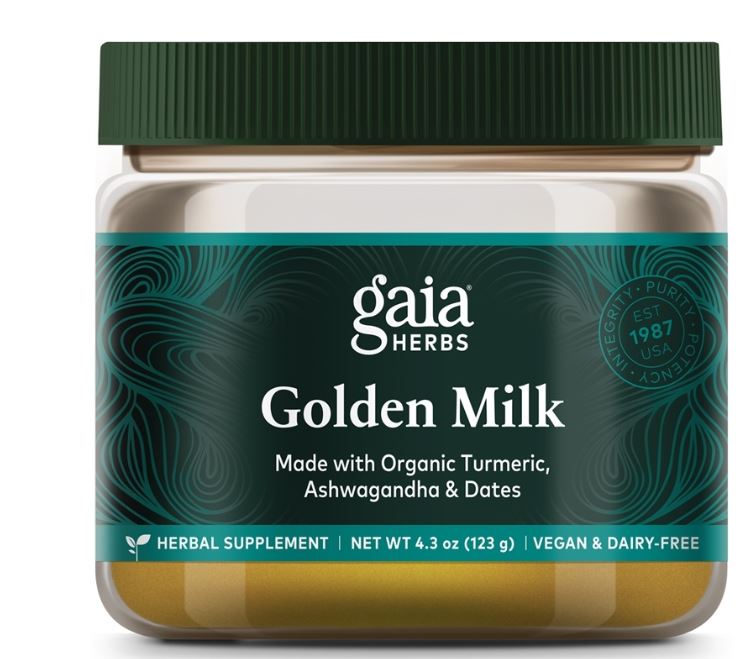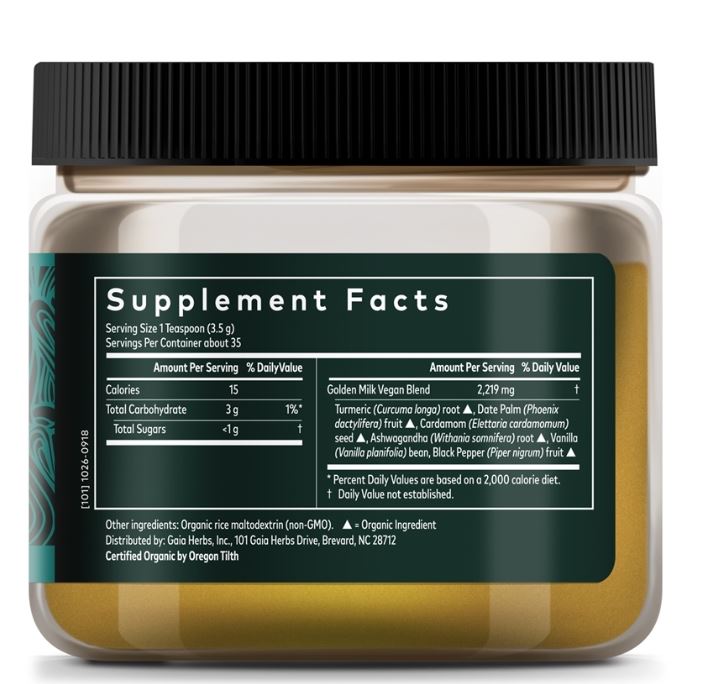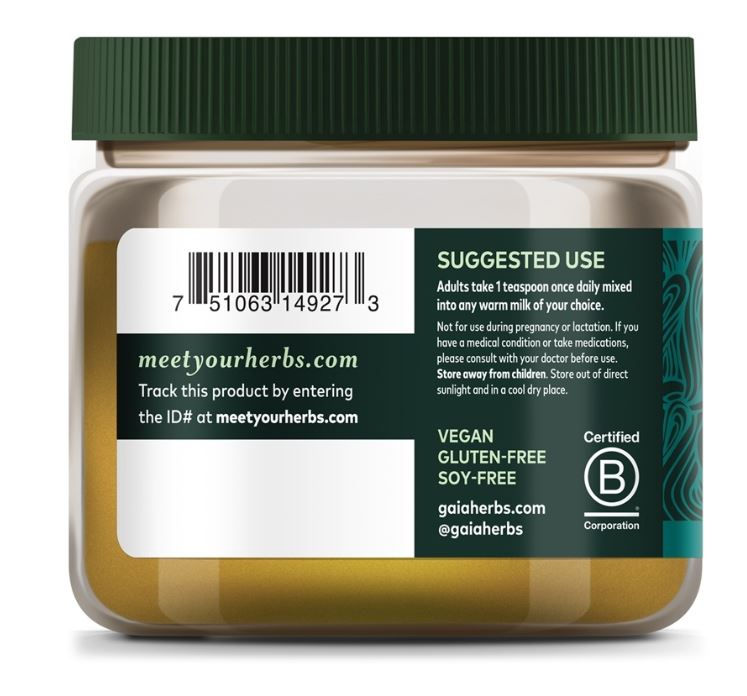Overview
Description
Gaia Herbs - Vegan Golden Milk - 4.3 oz. (123 g)
Gaia Herbs Vegan Golden Milk is based on the traditional Ayurvedic recipe that has been savored for centuries and used to support the mind and body in a number of ways. Within the ancient branch of medicine in India known as Ayurveda, Golden Milk is a tonic that’s meant to be nourishing, while also tasting delicious. Golden Milk takes its color from Turmeric, which they combine with other traditional Ayurvedic herbs like Black Pepper, Cardamom, Vanilla and Ashwagandha. This product is vegan and gluten-free with no GMOs or soy.
Gaia Herbs Golden Milk Features:
- Powdered Turmeric Supplement
- Delicious blend of Turmeric, Ashwagandha & Dates
- Supports the Mind & Body in Many Ways
- Ayurvedic
- Vegan & Vegetarian
- Dairy Free
Ingredients
Ashwagandha
This plant is a member of the Solanaceae family and has over 4,000 years of traditional use in its native India, Pakistan and Sri Lanka. It is a Medharasayan which is the Ayurvedic category of foods and nutrients that promote learning and memory retrieval. It is sometimes referred to as “Indian Ginseng” as it is traditionally used in conditions of debility, emaciation, impotence and premature aging. It is also sometimes referred to as Winter Cherry.
The translation of Ashwagandha is roughly, “the smell and strength of a horse”, alluding to its aphrodisiac properties. This plant is a Tonic and an Adaptogen. In the Middle East it is used to help promote normal sleep patterns and encourage a healthy inflammatory response. Adaptogens support the ability of an organism to cope with stress and thereby conserve energy. Ashwagandha rejuvenates and tonifies the entire system, especially the endocrine and immune systems.
Black Pepper
The dried fruit of Black Pepper (Piper nigrum) has long been used as a culinary spice and as a traditional medicine, and today it is ubiquitous in most cuisines. Black Pepper is made from the plant’s unripened green drupes (stone fruit), which are called “peppercorns.” They are briefly boiled and dried or cooked. Native to southern and southeast Asia, Black Pepper’s use in Indian cooking dates to the first century BC, and it became popular across Europe during the Roman Empire. In ancient Greece, it was so valued that it was used as currency. The active constituent called Piperine is what gives Black Pepper its pungency. In Ayurveda, Black Pepper is a very common herb. It is traditionally considered to be a hot, pungent herb that stimulates agni, or digestive fire, by supporting the secretion of fluids in the GI tract.
Cardamom
This member of the Ginger family (Zingiberaceae) hails from India. Interestingly, Guatemala is the largest exporter of Cardamom seedpods today, followed by India. The seeds have an incredibly strong, aromatic, almost intoxicating aroma and while black Pepper was called the King of Spices, Cardamom has been called the Queen. The seeds have been traded as a commodity and are reputed to be the third most expensive spice by weight next to saffron and vanilla. It has found its way into regional cuisine in India, Southeast Asia, China, Finland, and many other countries. One of the most refreshing ways to experience Cardamom is to drink a fine cup of Chai spiced with cardamom. The seeds contain a very high amount of volatile oils, characteristic of so many of the aromatic plants and have been used medicinally as a digestive aid by most cultures.
Traditional cultures and literature reference Cardamom as a Stomachic and Carminative. Both of these functions relate to digestion, the former promoting and assisting digestion and the latter to assist in the expulsion of intestinal gas or the reduction of gas production by the digestive apparatus. The main activity of Cardamom can be attributed to the volatile oils which give it the distinct flavor and aroma. These volatile oils promote the absorption and elimination of gas, while improving digestive function and providing natural support to the intestine.
Date Palm
The Date Palm (Phoenix dactylifera) likely originated in the Fertile Crescent, and fossil records show this plant dates back 50 million years. Today it is widely cultivated across tropical and subtropical regions worldwide. Date Palm fruit has been a staple in the Middle East for thousands of years, and today it is made into syrup, paste, vinegar, sugar and wine.
Turmeric
Indigenous to Southeastern and Eastern Asia, this perennial member of the Zingiberaceae family has been used for thousands of years as a traditional medicine, coloring agent and spice. Currently India accounts for much of its cultivation. It is known as Shati in Sanskrit. Reports of its use as a medicine go as far back as 600 BC in Assyrian herbal accounts and can also be traced to Greek writings from Dioscorides. It has been used to support healthy digestion, promote cardiovascular health, and support the immune system as well as used topically and in the eyes in Ayurvedic medicine. In Western herbal medicine Turmeric is used as an aromatic bitter and for supporting healthy liver function.
Most of the clinical research has been conducted in-vitro and primarily on animal cells using the isolated constituents. Turmeric extracts have shown considerable pharmacological activity, but the exact modes of its actions are not yet fully understood. Most researchers agree that the basic mechanism of action within Turmeric is its potent antioxidant action. Curcuminoids seem to scavenge for damaging particles in the body known as “free-radicals”.
Vanilla
Vanilla is sourced from a Mexican species of orchid, Vanilla planifolia. Each orchid must be hand-pollinated, a labor-intensive task. As such, Vanilla is the second most expensive spice by weight, after Saffron. Vanilla has historically been considered an aromatic stimulant that provides support for the nervous system. It also was used traditionally as an aphrodisiac, but today Vanilla is primarily used for its aroma and flavor. The main component of vanilla is vanillin, which provides it primary flavor and aroma.
Suggested Use
Adults take 1 rounded teaspoon once daily mixed into any warm milk of your choice.
Ingredients
| Gaia Herbs - Vegan Golden Milk - 4.3 oz. (123 g) | |||||||||||||||||||||||||||||||||||||||||||||
|
|||||||||||||||||||||||||||||||||||||||||||||
| Other Ingredients: Organic rice maltodextrin (non-GMO). ^= Organic Ingredients | |||||||||||||||||||||||||||||||||||||||||||||
Warnings
Questions & Answers
2 Reviews
Needless to say, after a week or so I quit using. They need to be smoother and actually have the ability to dissolve.




















It works!
Recommended by a friend
trying a new brand of zinc lozenge
Good for colds etc..